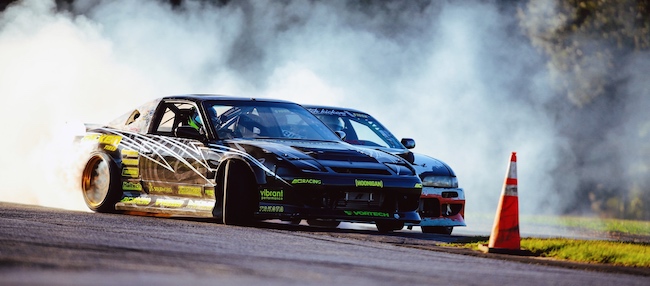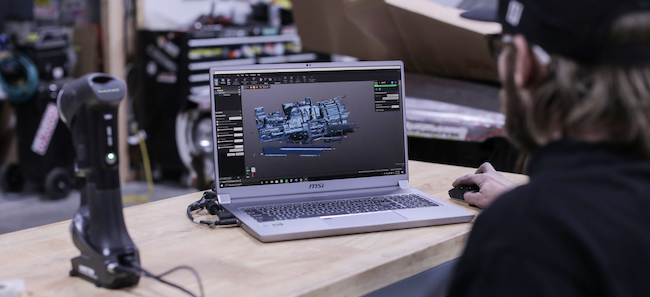
Back in the Driver’s Seat
By Creaform
CAD/CAM/CAE AutomotiveUndaunted designer modifies racecars to help disabled drivers return to the track.

A purely hand-controled Nissan 180SX drift racecar modified by Alberta’s Rob Parsons, founder of the Chairslayer Foundation. (Photo credit: Chairslayer Foundation)
For Lethbridge, Alberta-native, Rob Parsons, there’s a further technological challenge to this extreme motor sport. In 2011, the competitive auto and motocross racer was left paralyzed from the waist down following a life-changing motorbike accident.
During his recovery, Parsons set himself the task of designing a unique hand control system with which to operate the clutch, brakes, gear shift and throttle of a racecar so that he, and others, could resume their passion for drift racing.
Building a Drift Car
Parsons’ journey started with a Nissan 180SX chassis to which he added custom structural reinforcements in key areas. By hacking the front and rear of the chassis to almost nothing, he made room for a 650-hp, 6.2-liter LS V8 from Speedmasters and a T56 Magnum six-speed manual transmission.
To this point, Parsons relied on professional advice from part manufacturers. The design of a novel hand-control system, however, wasn’t something that original part suppliers had worked on before; he’d have to engineer it himself. In short, he had to find a way to replicate all of the functionalities of the acceleration and brake foot pedals, while also allowing for quick shifting and use of the hand brake. And it had to be operated by one hand.
Although the mechanics seem basic, Parsons says the real challenge was the control of the clutch and the gearbox. Indeed, operating these with precision and speed is critical to executing all of the drifting manoeuvres needed to compete at a professional level.
To design a solution, he relied on a few innovative technologies, including Creaform’s HandySCAN 3D Silver Series scanner. With it, he was able to extract the dimensional data from the race car’s T56 transmission to determine where a custom designed pneumatic shifter needed to be positioned.
Scanning the transmission also allowed Parsons to measure the position of each gear precisely after moving the shift rod from gear 1 to gear 6. Furthermore, the 3D scanner enabled him to measure the surrounding environment to make sure the movements derived from the new mechanism wouldn’t collide with any other components.

To help design his drift racecar’s hand control system, Parsons used a Creaform 3D scanner to create a CAD model of this T-56 manual transmission. (Photo credit: Creaform)
“With a laser scanner, you expect to get really detailed scans,” Parsons says, “and the HandySCAN 3D Silver Series definitely produces that.” Having the mesh so finely detailed, in addition to being cleaned and aligned, is a huge benefit when trying to line up holes and accurately measure features and diameters that will need to be machined out. “You don’t need to take out a caliper to check everything up,” he adds.
Hand Controls
With the transmission modifications in place, Parsons moved on to the right-hand drive car’s unique hand controls. For most functions, the system relies on control arm mounted on the steering column, where the turn signal would be.
Reminiscent of motorcycle handle bar, the control arm incorporates a motorcycle clutch lever to engage the systems electronic clutch-by-wire system, while buttons near the thumb position control up and down shifting.
The control arm also takes the place of the brake and gas peddles; pulling the arm down accelerates while pushing it away engages the brakes. This configuration allows the driver to both brake and accelerate at the same time (pulling down while pushing the arm forward). In addition, a large vertical lever, near the steering column, engages the race car’s hand-brake. Taken together, the system enables the driver to initiate the lightning-quick clutch kicks, gear up- and down-shifts and the prolonged skidding maneuvers characteristic of drift racing.
Instead of relying on expensive physical prototypes, Parsons says he was able to make changes to the hand controls directly in the CAD model before machining the parts. Using the scanner also meant a better design that became a perfectly fitting part the first time.
While Parsons’ unique hand control system enabled him to go back on the track and drift again, he didn’t stop after his first laps and adrenaline rushes.
Seeing how his story inspired others with disabilities, Parsons founded the Chairslayer Foundation. His non-profit organization helps get paraplegics behind the wheel of high-performance cars, like his hand-controlled drift car, slamming on the accelerator and having some extreme fun burning rubber.
www.chairslayer.org
www.creaform3d.com
This article was contributed by Creaform.
